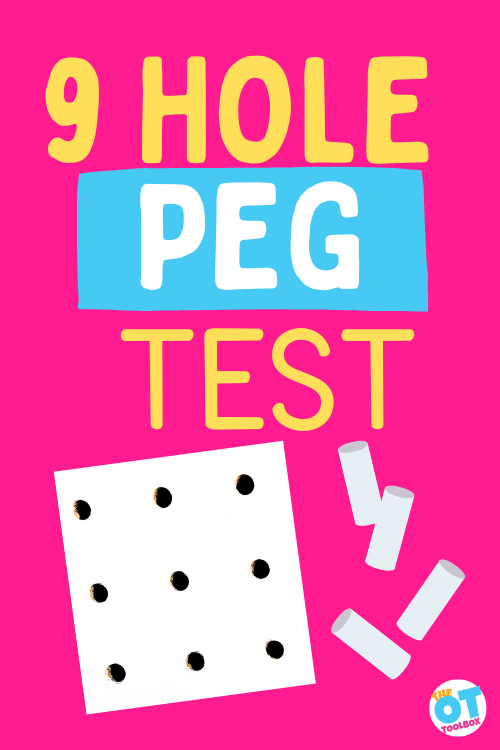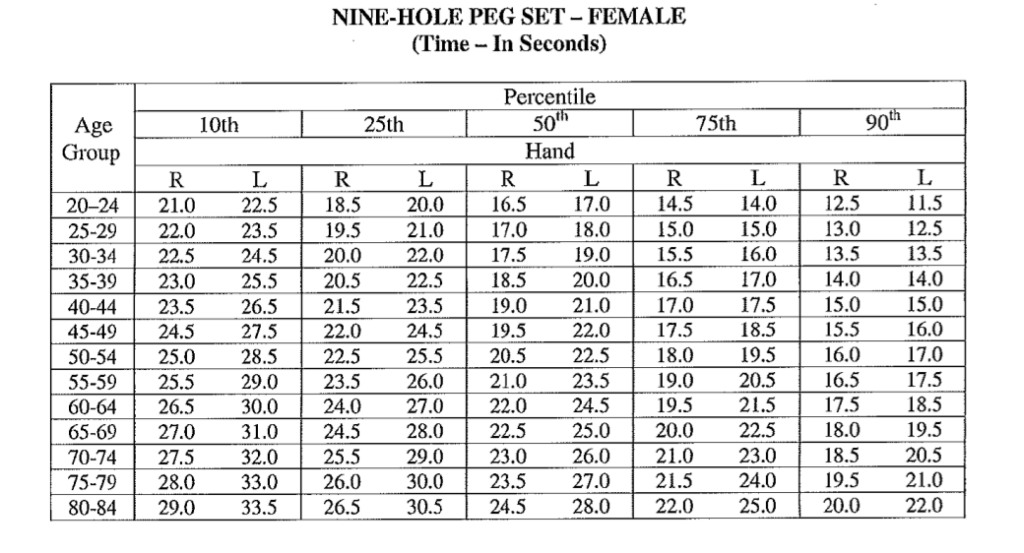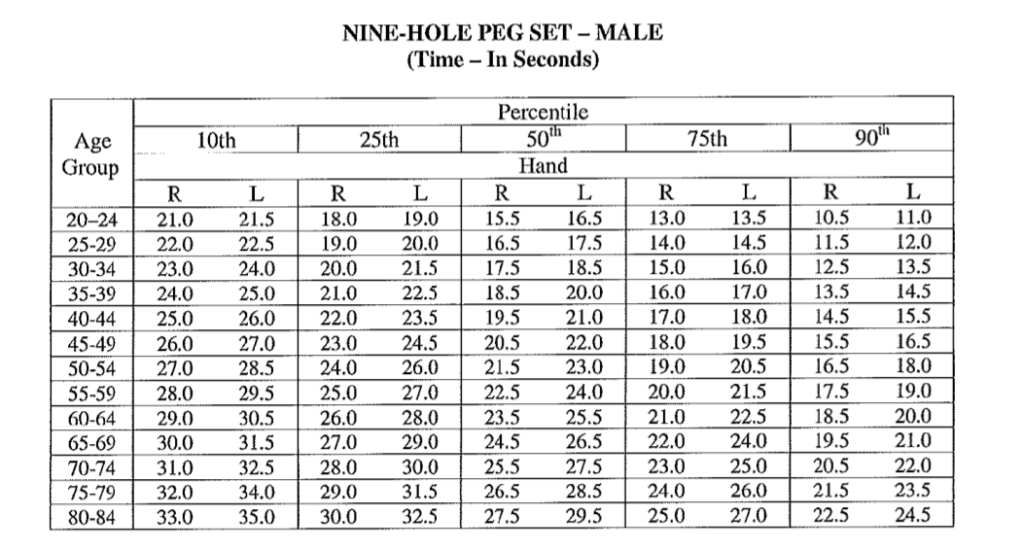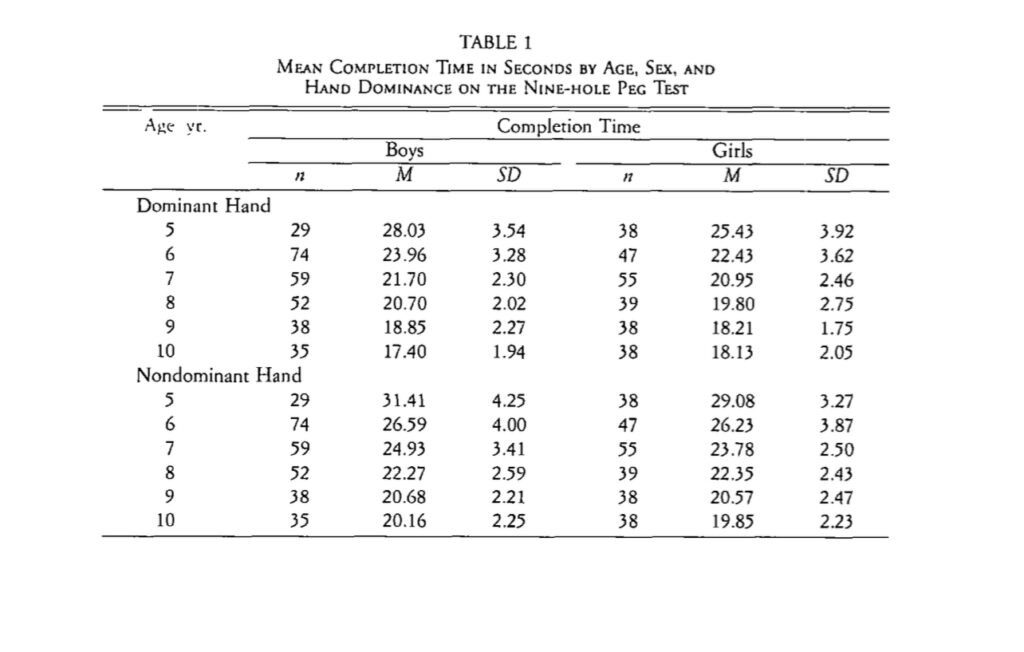The 9 hole peg test is a common fine motor test used in occupational therapy assessments to collect a baseline on fine motor skills, dexterity, hand-eye coordination, motor planning, and more. When an occupational therapist uses a nine hole peg test in OT evaluations, several areas of data are collected to support and drive therapy progression. Let’s take a closer look at this fine motor assessment and the skills developed using pegboard activities like the nine hole peg test.

This blog post on the 9 hole peg test contains affiliate links.
Amazon affiliate links are included in this blog post. As an Amazon Influencer, I earn from qualifying purchases.
9 Hole Peg Test
Continuing in the series of posts related to grasping, grip strength, and standardized testing measures, the (Amazon referral) 9 Hole Peg Test is another classic test used to measure and track fine motor dexterity. In this post we will review the nine hole peg test, norms, correct testing protocol, and testing options.
The Nine-hole Peg Test typically is used in the adult clinical settings such as outpatient hand therapy, rehabilitation settings, or in assessment of adults with coordination and dexterity needs, typically seen with neurologically impaired or cognitive, sensory, or motor impaired patients.
However, we know that in children, especially in the 5-9 range, much of the day revolves around motor skills, particularly fine motor contributions. We’ve covered in a previous blog post, the vast amount of school and learning tasks that involve fine motor work. Read about fine motor skills needed at school for more information.
- In this test, participants are asked to place pegs into the holes one at a time, then remove them one at a time, and place them back in the container as fast as they can
- Participants may only use one hand at a time, but the opposite hand can stabilize the board
- Alternative testing method: record the number of pegs placed in the peg holes in 30, 50, or 100 seconds. Record the data as number of pegs/second.
- Another alternate testing method: record the number of peg placed in the peg holes and seconds before the child loses interest. First, record the number of pegs. Second, record the number of pegs placed/second.
- The timer starts the second the hand touches the first peg, and ends when the last peg is placed into the container.
Versions of 9 hole peg test:
There are different varieties of the 9 hole peg test available for purchase, from a basic board (affiliate link) to the gold standard Jamar 9 Hole Peg Test.
The Jamar test is reported to be worth the hefty price tag because: “The placement of the dish and pegboard allows for an easy, consistent reach, which ensures proper results during the evaluation procedure. Thanks to the design and materials, the kit is also easy to clean and maintain, allowing for quick and easy disinfection to prevent any contamination”.
How to Administer the 9 Hole Peg Test
The nine hole peg test is a convenient testing instrument. It requires the test kit, a pencil and paper, and a stopwatch or other timing device.
- Set up the pegboard on a flat surface in front of the learner. Add a grip or non-slip surface to insure the board does not move. The peg side of the board is placed toward the dominant hand (when testing the non-dominant side, this will be reversed).
- Instruct the learner to: “Pick up the pegs one at a time, using your right (or left) hand only and put them into the holes in any order until the holes are all filled. Then remove the pegs one at a time and return them to the container. Stabilize the peg board with your left (or right) hand. This is a practice test. See how fast you can put all the pegs in and take them out again. Are you ready? Go!”
- After the patient performs the practice trial, instruct the patient: “This will be the actual test. The instructions are the same. Work as quickly as you can. Are you ready? Go!” (Start the stop watch when the patient touches the first peg.) While the patient is performing the test say “Faster” When the patient places the last peg on the board, instruct the patient “Out again…faster.” Stop the stop watch when the last peg hits the container. Place the container on the opposite side of the pegboard and repeat the instructions with the non-dominant hand.
- Record the number of seconds to place and remove all nine pegs for the dominant and non dominant hand. Testing will include one practice test, one test for dominant hand, and one for the non-dominant hand.
- Create a tracking form to track scores over time.
- Cross reference the scores of your learner with standardized norms.
Fine Motor Assessments with the 9 Hole Peg Test
There are several tests that incorporate the 9 hole peg test within their testing protocols:
- Wide Range Assessment of Motor Abilities – WRAVMA
- Bruininks Oseretsky Test of Motor Proficiency – BOT2
- Purdue Pegboard Test of Dexterity
- Lafayette Dexterity Assessment Battery
Skills Assessed with a Nine Hole Peg Test
Once a measurement is assessed, different pegboard type activities can be used to encourage and strengthen dexterity. While these will not be standardized with norms, they can be measured over time for improvement or decline in function.
Skills that the nine hole test analyzes can include:
- In-hand manipulation
- Precision
- Dexterity
- Hand-eye coordination
- Separation of the sides of the hand
- Force modulation
- Cognition
There are endless resources and activities available to address fine motor precision. This article from the OT Toolbox on Fine Motor Precision contains valuable information.
Here is an inclusive post on Fine Motor Skills, also from the writers at the OT Toolbox.
When Use the 9 Hole Peg Test
You might be wondering why do we need to use measurements like the 9 hole peg test?
Unfortunately (or fortunately depending on your perspective) therapists and practitioners are held to higher and higher standards. There is a certain amount of accountability that is being expected in practice. This is largely due to insurance regulations, however it is good practice to be able to show measurable progress.
By using standardized methods to record and gather data, more accurate measurements can be made to document and demonstrate what is happening in therapy. “They are doing a great job” or “we are making nice progress” was sufficient evidence at one time.
I personally like standardized tests. It keeps me on top of my students, helps me justify what I do, and is less likely to be questioned than a random worksheet or coloring page. With children, it is hard to make sure a test is exactly standardized to precise measurements, however, it is more measurable than “they are doing a great job”.
If you are a new clinician, take time to study and learn various types of assessments. If you are seasoned, brush up on your skills, dust off old assessments, or continue using the gold standard in your practice.
9 Hole Peg Test Norms
A clinician can use results of the 9 hole peg test to assess the skill areas above but a standardized test should be used. Norms can be used to determine needs, strengths, and skills that can be addressed in therapy sessions for functional participation in daily activities.
Norms for the nine hole peg test vary and are separated by age, including different norms for children as opposed to adults. The norms can also be broken down by diagnoses like Parkinson’s Disease or Stroke, as well as healthy individuals.
Use the 9 hole peg test norms to determine if dexterity, coordination, precision, in-hand manipulation, eye-hand coordination are delayed.


Data differs between the ages of 5 though 10. During these ages, we see a huge amount of fine motor development occurring. We see this progression in ability to form smaller letters with a pencil, complete more intricate craft activities, build with more refined blocks, color with more dexterity, etc.

This article breaks down normative data into nice charts that can be used to determine baseline levels and skill development.
This report also breaks down norms for the 9 hole peg test.
Variations exist with differences in dominant hand, non-dominant hand, other needs (called special education students in some reports), diagnoses, age, male/female, and other considerations.
NOTE*The term, “learner” is used throughout this post for readability and inclusion. This information is relevant for students, patients, children and/or adults of all ages and stages or whomever could benefit from these resources. The term “they” is used instead of he/she to be inclusive.
- References: Mathiowetz V, Weber K, Kashman N, Volland G. Adult Norms for the Nine Hole Peg Test of Finger Dexterity. The Occupational Therapy Journal of Research. 1985;5:24-33
Working on fine motor skills, visual perception, visual motor skills, sensory tolerance, handwriting, or scissor skills? Our Fine Motor Kits cover all of these areas and more.
Check out the seasonal Fine Motor Kits that kids love:






Or, grab one of our themed Fine Motor Kits to target skills with fun themes:
- Frogs Fine Motor Kit
- Unicorns Fine Motor Kit
- Vehicles Fine Motor Kit
- Apple Fine Motor Kit
- Back to School Kit
- Sports Fine Motor Kit
- Outer Space Fine Motor Kit
- Fairytale Fine Motor Kit
- Plus more in our shop!
Want access to all of these kits…and more being added each month? Join The OT Toolbox Member’s Club!

Victoria Wood, OTR/L is a contributor to The OT Toolbox and has been providing Occupational Therapy treatment in pediatrics for more than 25 years. She has practiced in hospital settings (inpatient, outpatient, NICU, PICU), school systems, and outpatient clinics in several states. She has treated hundreds of children with various sensory processing dysfunction in the areas of behavior, gross/fine motor skills, social skills and self-care. Ms. Wood has also been a featured speaker at seminars, webinars, and school staff development training. She is the author of Seeing your Home and Community with Sensory Eyes.






